RAM Concept 2023 v23.00.01.041
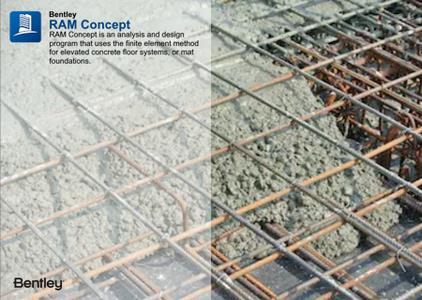
Free Download RAM Concept 2023 v23.00.01.041 | 2.1 Gb
The Structural Products development team is pleased to announce the availability of RAM Concept 2023 (23.00.01.041)is structural software for the design of post-tensioned and reinforced concrete floors including slabs, mats, and rafts.
Owner:Bentley Systems Inc.
Product Name:RAM Concept
Version:2023 (23.00.01.041)
Supported Architectures:x64
Website Home Page :www.bentley.com
Languages Supported:english
System Requirements:Windows *
Size:2.1 Gb
RAM Concept 2023 (v23.00.01) Release Notes – Release Date: December 2023
Installing this update will automatically uninstall RAM Concept 2023 (v23.00.00). However, this update can be installed concurrently with previous versions of RAM Concept older than v23.00.00.
File Compatibility Warning
RAM Concept v23.00.01 can read all previous file formats, it but writes files in a format that cannot be read by previous versions.
RAM Concept v23.00.01 includes the enhancements discussed below.
AS 3600-2018 Amendment #2
AS 3600-2018 Amendment #2 is now implemented. Refer to the chapter titled AS 3600-2018 Design in the RAM Concept manual for detailed notes on the implemented design code changes. To use this design code in new files, open the New File dialog and select AS 3600 in the Code menu and 2018 (Amd. #1 & #2) in the Version menu as shown in the image below.
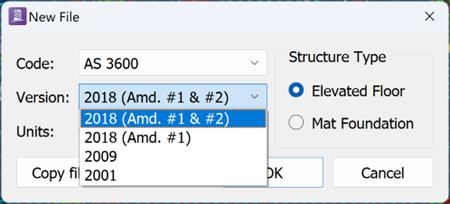
To select this code in existing files, open the Calc Options dialog and select AS 3600-2018 Amd. #1 & Amd. #2 in the Design menu. The currently implemented AS 3600-2018 (Amd. #1) version remains implemented as a separate design code selection.
Option to Include Vertical Prestress Component in Strength Design Calculations (available for AS 3600-2018 Amd. #1 & Amd. #2 only)
The vertical prestress component (Pv) can now be considered in the Strength Design checks for the AS 3600-2018 design code. The option to include this component is available in the Span Properties and Design Section Properties dialogs as shown in the images below.
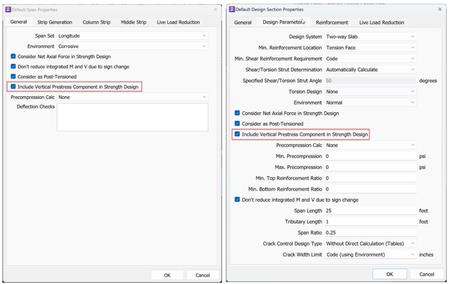
When included in the design, Pv is factored by 0.9 if it acts to reduce the design shear and by 1.15 if it increases the design shear per clause 8.2.1.3 or changes its direction. Pv forces are summed with the design force envelopes during the shear envelope conversion. The resulting summed shear value including Pv is the shear demand value used in the design calculations and output in the section analysis tables and Descriptions. The option is disabled and Pv is ignored if the Consider as Post-Tensioned option is not selected
Description Settings – Strip Selection Filter for Latitude and Longitude Span Sets
Descriptionted design strip results can now be filtered by latitude and longitude span sets using the Strip Selection filters in the Description Settings dialog that are marked in the image below. For example, when the Latitude box is checked and the Longitude box is unchecked, only strip results for the latitude design strips are displayed. The new Strip Selection filters are available for Strip, Section Analysis, Section Design, and Deflection Check results.

Other Changes
RAM Concept v23.00.01 also includes the changes discussed below.
ACI 318-19 Design – Determination of As for One-Way Shear Strength when Tensile Reinforcement not Found
In previous versions, the one-way shear capacity was calculated assuming As = 0 when no tensile reinforcement was found in the section. This most often occurred when the section was subject to compression strain only or very low bending moments that resulted in 0 strain across the entire section. This assumption resulted in very low calculated concrete shear strengths using the equations in ACI 318-19 Table 22.5.5.1, which led to unexpected design failures or transverse reinforcement requirements. Now, As is determined using the reinforcement in the extreme layer on the least compression face. This assumption follows from the commentary in ACI 318-19 R22.5.5.1.
AS 3600-2018 Design – Shear Strength Calculation when User Transverse Reinforcement Shear Density is Less than Minimum Required
In previous versions, the contribution of user transverse shear reinforcement (Vus) to the design shear strength (Vu) was ignored when the shear density was less than the minimum density defined in AS 3600-2018 8.2.1.7 but the spacing was less than the maximum required spacing. Now, the calculation of Vu considers the contribution of Vus when this condition occurs. In design check only mode, a design code failure is still flagged for these sections since the minimum shear density requirement is not satisfied. User transverse reinforcement continues to be ignored in the shear capacity calculations when the reinforcement spacing exceeds the maximum spacing limits defined in clause 8.3.2.2. These changes affect both the AS 3600-2018 Amd. #1 and AS 3600-2018 Amd. #1 & #2 design code selections.
AS 3600-2018 Design – Consideration of PT System Duct Width in Effective Shear Width Calculation
For AS 3600-2018, the prestressing ducts are included in the effective web width for shear (bv) if the sum of the duct widths meets the requirement clarified in AS 3600-2018 Amd. #2 8.2.1.5. The effective web width for bonded PT ducts is also now calculated using a kd value determined from the duct material property (plastic or steel) that is defined in the PT Systems Material table These changes affect both the AS 3600-2018 Amd. #1 and AS 3600-2018 Amd. #1 & #2 design code selections.
Default Cracked Section Concrete Stress Plans for AS 3600-2018 Initial Service Design
The following are now default plans on the Initial Service Design Layer for new models created with an AS 3600-2018 design code selection:
– Top Cracked Concrete Stress Plan
– Bottom Cracked Concrete Stress Plan
These plans can be added in existing models with an AS 3600-2018 design code selection by clicking Criteria > Rebuild Load Combos
Resolved Issues
RAM Concept v23.00.01 includes fixes for the issues discussed below.
Program Crash when Importing DWG Files with Proxy Objects
A crash occurred when attempting to import DWG files containing proxy objects for custom objects created by ObjectARX applications. RAM Concept now ignores proxy objects when importing affected files.
Load Combination Identified by ID Number in Load History Table
In the Load History Table, load combinations defined with non-zero standard factors for both the Balance and Hyperstatic Loading were identified by an internal ID number instead of the defined load combination name as shown in the image below.

Ram Concept is designed to exclude all load combinations that include the Hyperstatic Loading as selections in the Load History Table. This problem only occurred when a load combination was referenced in the table and the Hyperstatic load factor for that combination was later changed to a non-zero value. When this issue occurred, all calculations were completed using the correct load combination with its unexpected load factor for the Hyperstatic Loading. RAM Concept now prevents changes to the Hyperstatic Loading load factor if the load combination is referenced in the Load History table. The error message displayed in the image below is displayed when this change is attempted.

Punching Shear Checks Completed after Setting Active Design Rules to None
Punching shear calculations may have been completed when a Strength Design Rule was defined with the Punching Shear Design box checked and the Active Rule selection was changed.

Punching shear design is now disabled when the Active Rule selection is changed from Strength Design.
Error Synching RAM Concept Reinforcement Data with iTwin Repository. An exception error occurred when attempting to push RAM Concept user reinforcement data into an iTwin repository from RAM Structural System. This error stopped the synchronization process and prevented the iTwin repository from being updated. This issue only affected RAM Concept files saved within RAM Structural System .rss files. It did not affect RAM Concept .cpt files that were synched with RAM Structural System and saved separately from the .rss file. RAM Concept user reinforcement data saved in RAM Structural System files can now be exchanged with iTwin repositories without issue.
Incorrect Display of PT Anchors Pushed from RAM Concept into an iTwin Repository
The orientation of PT anchors pushed from RAM Concept into an iTwin repository were not displayed correctly relative to its associated tendon. The orientation was also not updated after its associated tendon was moved in RAM Concept and changed in an existing iTwin repository. The orientation of PT anchors is now exchanged between RAM Concept and iTwin repositories without issue.
Early Access Program – iTwin Synchronization to Cloud Workflow
The Early Access Program (EAP) for the iTwin Synchronize to Cloud Workflow continues with this version. A practical application of this technology is the ability for RAM Concept users push PT tendon profiles to a 3D analytical iTwin and review those profiles in elevation/cross section views across the floor as shown in the image below.
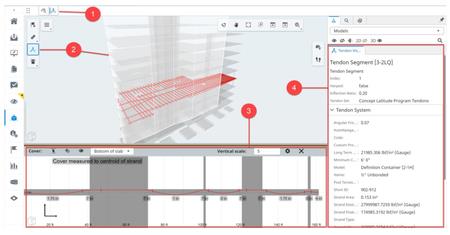
Figure 1 – Tendon Visualization Mode in iTwin Synchronize to Cloud Workflow
The tags in the image highlight tools and features available in this workflow:
– Tendon Visualization Mode – activates the Tendon Visualization mode when working in iTwin Analytical Design Review.
– Tendon Selection Tool – selects a tendon profile in the 3D View.
– Tendon Elevation View – displays the profile of the selected tendon in a floor cross section view. Use this view to review tendon cover dimensions at any point along the tendon profile.
– Tendon Property Pane – displays the properties of the tendon selected in the 3D View.
RAM Concept users can participate in the EAP and access the capabilities available in this workflow at no additional charge.
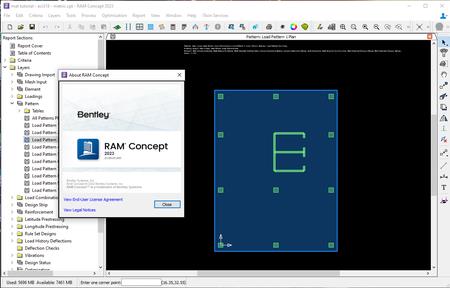
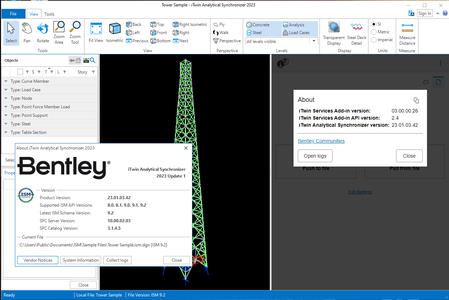
RAM Conceptis a software application for the structural analysis and design of conventionally reinforced and post-tensioned concrete floors, mats, and rafts. RAM Concept contains an advanced feature set that allows for the design of a wide variety of floor systems including post-tensioned, reinforced concrete and hybrid systems, elevated slabs and mat/raft foundations, one-way slabs, two-way slabs, beams, and joist systems. RAM Concept enables the engineer to design post-tensioned and reinforced concrete slabs by using a finite element model of the entire slab, and also can predict the elastic behavior of a slab much more accurately than frame models. In addition, the finite element method guarantees that the analysis satisfies all equilibrium.
In this RAM Concept training video, we introduce you to the new post-tension optimization workflow.
Bentley Systems, Inc.is the global leader dedicated to providing architects, engineers, constructors, and owner-operators with comprehensive architecture and engineering software solutions for sustaining infrastructure. Founded in 1984, Bentley has nearly 3,000 colleagues in more than 45 countries, $500 million in annual revenues, and, since 2001, has invested more than $1 billion in research, development, and acquisitions.

DONWLOAD FROM RAPIDGATOR
http://peeplink.in/1ff1534688e7DOWNLOAD FROM NITROFLARE
e7e4y.setup.rarDONWLOAD FROM UPLOADGIG
e7e4y.setup.rarFikper
e7e4y.setup.rar.html